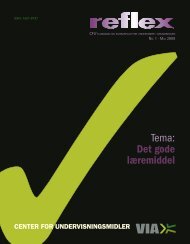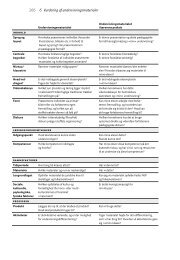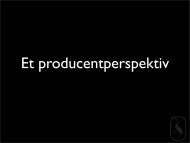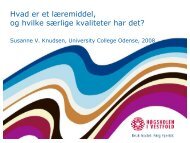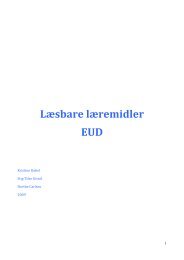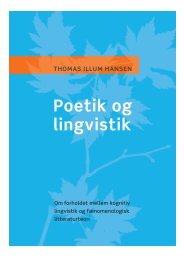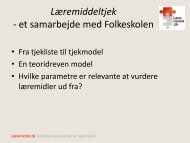- Page 1 and 2:
Ph.d.-afhandling v. Annemari Munk S
- Page 3 and 4:
Indholdsfortegnelse Indledning 6 Ba
- Page 5 and 6:
Kapitel 6. Sundhed som forbrugskult
- Page 7 and 8:
Indledning En dag begyndte skolen a
- Page 9 and 10:
Baggrund I starten af 2008 nedsatte
- Page 11 and 12:
selvbeskrivelse 12 , at undersøgel
- Page 13 and 14:
udgangspunkt i. Analysen af læremi
- Page 15 and 16:
forskningstraditioner (antropologi,
- Page 17 and 18:
Et lignende filosofisk perspektiv p
- Page 19 and 20:
har inspireret og bidraget til, sam
- Page 21 and 22:
fortællende arbejdsform. Via kompa
- Page 23 and 24:
kulturanalytiske tilgang, der for d
- Page 25 and 26:
pædagogiske debat. Analyserne har
- Page 27 and 28:
I dag taler man indenfor kulturanal
- Page 29 and 30:
en analyse af de civilisationskends
- Page 31 and 32:
Sprogspil og kultur Umiddelbart syn
- Page 33 and 34:
gør den fejl, at de tyder alle ord
- Page 35 and 36:
sammenhængende med og del af såve
- Page 37 and 38:
ytringer tilhører. 111 Pointen er
- Page 39 and 40:
Med forudsætningerne må vi tilbag
- Page 41 and 42:
Biopolitik og sandheden om menneske
- Page 43 and 44:
sundhed), og han understreger, at d
- Page 45 and 46:
gøre op med forestillingen om, at
- Page 47 and 48:
et felt med én synsvinkel, hvor an
- Page 49 and 50:
tilfælde er problematikken modsat;
- Page 51 and 52:
Om den historiske metode, skriver F
- Page 53 and 54:
fremstillingen af undersøgelsens r
- Page 55 and 56:
overordnet kodeord eller faste tema
- Page 57 and 58:
forebygge sygdomme. Ikke desto mind
- Page 59 and 60:
Bevægelsesbegrebet henviser også
- Page 61 and 62:
været inddraget, overvejet og anve
- Page 63 and 64:
Kapitel 3. Sundhedskulturelle tekst
- Page 65 and 66:
på vippen - en undersøgelse af de
- Page 67 and 68:
Dermed blev det også nødvendigt m
- Page 69 and 70:
er Sundhedstegnet (Sundhedsstyrelse
- Page 71 and 72:
I stedet undersøgte jeg, om der va
- Page 73 and 74:
Listen rummer de steder, en lærer
- Page 75 and 76:
De øvrige tidsskrifter er medtaget
- Page 77 and 78:
Kapitel 4. Sundhedskulturelle konte
- Page 79 and 80:
og pædagogikken som disciplinering
- Page 81 and 82:
4.2. Sundhedsfagets tilblivelse - t
- Page 83 and 84:
Skoler for derfra at brede sig i vi
- Page 85 and 86:
Op gennem 1900-tallet øgedes fokus
- Page 87 and 88:
og stillingtagen.” 293 Endvidere
- Page 89 and 90:
dansk, samtidsorientering, idræt o
- Page 91 and 92:
med et følelsesladet ord for indok
- Page 93 and 94:
I 1991 udkom på den baggrund en re
- Page 95 and 96:
- løftede pegefingre og moraliseri
- Page 97 and 98:
forbedres. På den måde blev sundh
- Page 99 and 100:
muligheder for forandring, og eleve
- Page 101 and 102:
centrum, er det generelt ud fra den
- Page 103 and 104:
frem for kognitiv, uforgængelig vi
- Page 105 and 106:
udgangspunkt i kendskab til legemet
- Page 107 and 108:
metoder til vedligeholdelse af dett
- Page 109 and 110:
folder sig om maven, tarmen og de a
- Page 111 and 112:
steder hvor føden beskrives udenfo
- Page 113 and 114:
problem. Men også modefænomener,
- Page 115 and 116:
‟legeme‟ således den objektive
- Page 117 and 118:
Som følge heraf bliver det af stø
- Page 119 and 120:
vi skal hver dag vaske hoved, hals,
- Page 121 and 122:
findes fordelt på hele legemets ov
- Page 123 and 124:
kugleformede, stavformede eller spi
- Page 125 and 126:
De steder, hvor billederne er taget
- Page 127 and 128:
Fortæl også om fornuftige og ufor
- Page 129 and 130:
Skolens sundhedspædagogiske praksi
- Page 131 and 132:
evarelse) synes helt afhængig af d
- Page 133 and 134:
På den led forlader vi kroppens in
- Page 135 and 136:
Materialet har især bemærket sig
- Page 137 and 138:
Det at spise er på den ene side bi
- Page 139 and 140:
Statens Husholdningsråd 1986/87a:f
- Page 141 and 142:
stoffet, der ikke længere centrere
- Page 143 and 144:
socialkultur. Dette understreges af
- Page 145 and 146:
I citatet knyttes sundheden (som i
- Page 147 and 148:
forbrugskultur at indskrive sig i e
- Page 149 and 150:
forældrene har smurt. 501 Lad os i
- Page 151 and 152:
Eksemplet illustrerer tydeligt, hvo
- Page 153 and 154:
Krumme fremstilles som det fremadst
- Page 155 and 156:
vi en række individuelle viljer, k
- Page 157 and 158:
Som noget nyt benyttes her en krops
- Page 159 and 160:
eleven selv er med til at forme, id
- Page 161 and 162:
andre madkulturer. Der kræves frem
- Page 163 and 164:
foranderlige, og som udgørende væ
- Page 165 and 166:
Hvor vi indtil nu har mødt sundhed
- Page 167 and 168:
Allerede i valget af så mange fors
- Page 169 and 170:
At det ikke er sund kost og motion,
- Page 171 and 172:
Mennesket har brug for mere end bar
- Page 173 and 174:
anfægtes af sin mors påpegning af
- Page 175 and 176:
sundheden: I den forbindelse møder
- Page 177 and 178:
Identiteten forankres med andre ord
- Page 179 and 180:
live bedre til at lægge mærke til
- Page 181 and 182:
Hagel 1991:56. For første gang mø
- Page 183 and 184:
dermed i sidste ende frigøre sig f
- Page 185 and 186: Hagel 1991:76. Det interessante er
- Page 187 and 188: Tilhørsforhold til fællesskaber -
- Page 189 and 190: andet og mere end den konkrete træ
- Page 191 and 192: 7.5. Sundhed som selvrealiseringsku
- Page 193 and 194: Kapital 8. Sundhed som mobilisering
- Page 195 and 196: 8.1. Undervisningsavisen og Tjek t
- Page 197 and 198: vurdere sit sundhedshjul er første
- Page 199 and 200: ustrukturerede aktiviteter, der i s
- Page 201 and 202: Henvendelsesformen er også en gans
- Page 203 and 204: men (næsten) fedtfrit. Tegnkulture
- Page 205 and 206: fornemmelse for at spise sundt, som
- Page 207 and 208: Den slanke, veltrænede og stærke
- Page 209 and 210: Det væsentligst bliver i den forbi
- Page 211 and 212: fremadskridende hjul (mobiliseringe
- Page 213 and 214: vilje, der i sidste ende er fundere
- Page 215 and 216: (tilsyneladende neutrale) afsendere
- Page 217 and 218: I opgavernes skal eleverne således
- Page 219 and 220: mulighed for, at den enkelte forfat
- Page 221 and 222: Opsamling Denne afhandling har unde
- Page 223 and 224: Som noget nyt opfordres eleven til
- Page 225 and 226: Dette skaber en ganske paradoksal s
- Page 227 and 228: Afhandlingen har beskrevet en udvik
- Page 229 and 230: Dette forhold sætter fokus på læ
- Page 231 and 232: Resumé Denne afhandling er histori
- Page 233 and 234: om legemet og dets pleje i en medic
- Page 235: English Summary This thesis is a st
- Page 239 and 240: Bibliografi Akselsen, Käte og Koch
- Page 241 and 242: Eichberg, Henning (1998): Body Cult
- Page 243 and 244: Gynther, Karsten (2008): Ny læremi
- Page 245 and 246: Jensen, Bjarne Bruun (1986a) Sundhe
- Page 247 and 248: Kruse, Søren (2007): Social ulighe
- Page 249 and 250: Nielsen, Niels Kayser (1993): Mr Fa
- Page 251 and 252: Schmidt, Lars Henrik og Kristensen,
- Page 253 and 254: Weber, Max (1994): Magt og bureaukr
- Page 255 and 256: Gladstone, Kim Herlev (1993): Uden
- Page 257 and 258: Fødevarestyrelsen (2007): Madklass
- Page 259 and 260: Beiring-Sørensen, Fin (1980): Skol
- Page 261 and 262: Barfoed, Lars (2005): Sund kost beh



